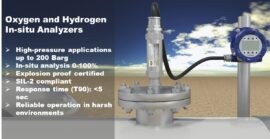
As the demand for hydrogen continues to grow as a clean and sustainable energy source, ensuring the safety and efficiency of hydrogen facilities becomes paramount. One critical aspect is the need to keep hydrogen facilities and piping fully isolated, minimizing the risk of leaks or accidents. At the same time, quality assurance is crucial to maintain optimal performance and reliability. In this regard, the use of in-situ analyzers suitable for high-pressure installations presents a valuable solution.
Hydrogen, being a highly flammable gas, requires stringent safety measures to prevent leaks or accidents. To ensure the safety of personnel and equipment, it is crucial to keep hydrogen facilities and piping fully isolated. Complete isolation minimizes the risk of hydrogen escaping into the environment, where it can pose a significant hazard.
The classification of an area as hazardous is an essential consideration in the design and operation of hydrogen plants. When multiple sample extraction points are present, there is an increased risk of gas leakage, which necessitates the classification of the area as Zone 2 of medium risk for the presence of gas potentially explosive. In the case of sample extraction methods, where samples are vented to the atmosphere, the locations where the extraction and venting occurs are often classified as Zone 1 areas where flammable gases may be present in normal operating conditions. This classification requires the implementation of stringent safety measures, including the use of certified equipment and controls designed for hazardous environments.
However, by eliminating the need for sample extraction and utilizing in-situ analyzers, the area classification can be reevaluated. In-situ analyzers operate directly within the process piping, eliminating the potential for gas leaks associated with sample extraction points. As a result, the area can be reclassified as general purpose, which significantly reduces the cost and complexity of the overall hydrogen plant facility.
By reclassifying the area as general purpose, the plant can benefit from the use of standard, non-hazardous area equipment, which is often more readily available and less expensive compared to specialized hazardous area-certified solutions. This provides greater flexibility in equipment selection and reduces the overall project cost. Furthermore, reclassifying the area as general purpose simplifies the design and construction of the hydrogen plant facility. It eliminates the need for complicated hazardous area wiring, instrumentation, and explosion-proof enclosures, streamlining the installation process and reducing associated costs. The simplified design also facilitates future modifications or expansions, allowing for more agile and cost-effective operations.
In addition to safety considerations, maintaining high-quality hydrogen is essential for optimizing performance and reliability. Impurities, such as moisture, oxygen, and other contaminants, can have detrimental effects on the efficiency of various hydrogen-dependent processes, including fuel cells and industrial applications. To ensure the purity of the hydrogen stream, quality assurance practices must be implemented. Traditionally, sample extraction points have been used to analyze hydrogen quality, requiring sample extraction and subsequent on-line or laboratory analysis. However, this approach has limitations, such as potential for cross-contamination and delays in obtaining results.
To address the limitations of conventional quality assurance methods, the use of in-situ analyzers suitable for high-pressure installations offers significant advantages. These analyzers are specifically designed to operate directly within the hydrogen infrastructure, eliminating the need for sample extraction points. By installing in-situ analyzers at strategic locations within the hydrogen facility, operators can continuously monitor the quality of the hydrogen stream in real-time. These analyzers provide immediate feedback on impurity levels, allowing for prompt corrective actions if deviations from desired specifications occur.
In the context of hydrogen production and distribution, ensuring safety, efficiency, and quality assurance is vital. By keeping hydrogen facilities and piping fully isolated and employing in-situ analyzers suitable for high-pressure installations, these objectives can be effectively achieved. In-situ analyzers offer numerous benefits, including enhanced safety, improved efficiency, cost savings, and accurate data. Embracing this advanced technology is a significant step towards optimizing hydrogen operations and paving the way for a sustainable and reliable hydrogen economy.
In conclusion, the elimination of sample extraction points and the utilization of in-situ analyzers offer significant benefits in terms of area classification and cost reduction. By removing the potential for gas leakage, the area can be reclassified as general purpose, eliminating the need for costly hazardous area-certified equipment and controls. This reclassification not only reduces project expenses but also simplifies the design, installation, and future scalability of hydrogen plant facilities.






